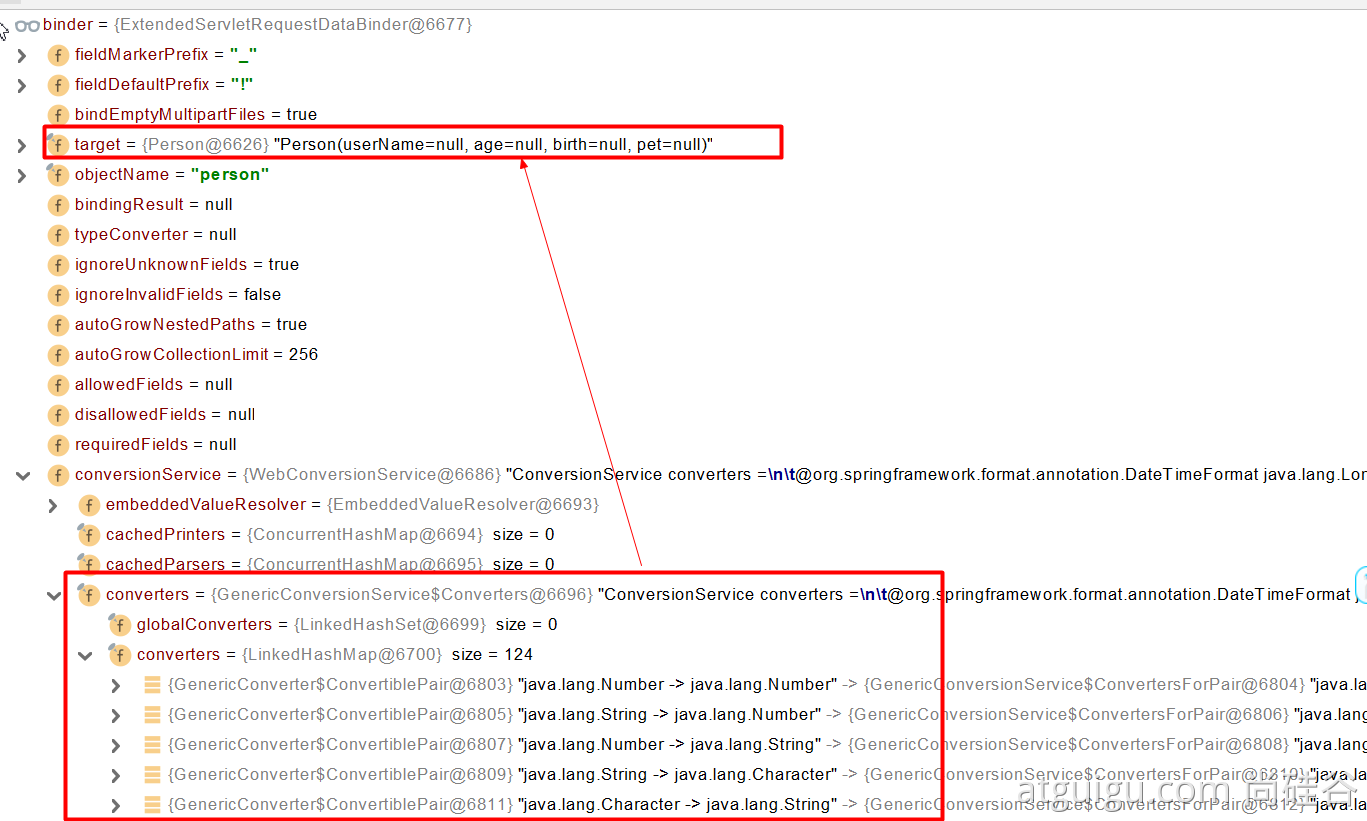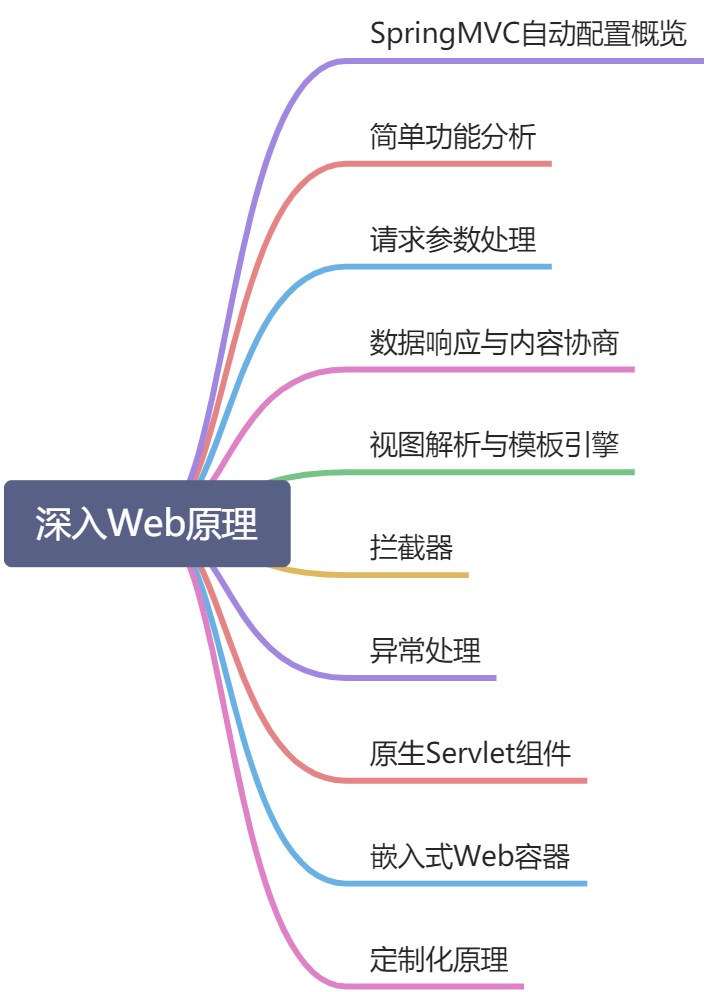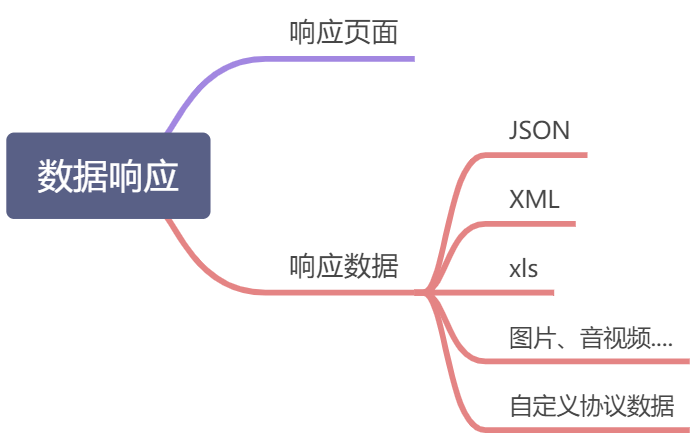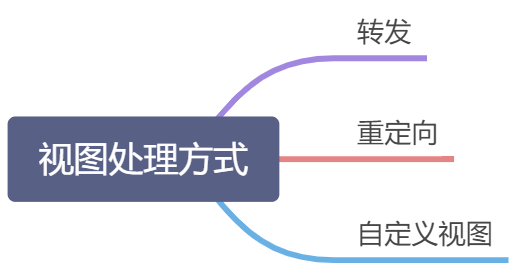1、SpringMVC自动配置概览
Spring Boot provides auto-configuration for Spring MVC that works well with most applications.(大多场景我们都无需自定义配置)
The auto-configuration adds the following features on top of Spring’s defaults:
- Inclusion of ContentNegotiatingViewResolver and BeanNameViewResolver beans.
- 内容协商视图解析器和BeanName视图解析器
- Support for serving static resources, including support for WebJars (covered later in this document)).
- 静态资源(包括webjars)
- Automatic registration of Converter, GenericConverter, and Formatter beans.
- 自动注册 Converter,GenericConverter,Formatter
- Support for HttpMessageConverters (covered later in this document).
- 支持 HttpMessageConverters (后来我们配合内容协商理解原理)
- Automatic registration of MessageCodesResolver (covered later in this document).
- 自动注册 MessageCodesResolver (国际化用)
- Static index.html support.
- 静态index.html 页支持
- Custom Favicon support (covered later in this document).
- 自定义 Favicon
- Automatic use of a ConfigurableWebBindingInitializer bean (covered later in this document).
- 自动使用 ConfigurableWebBindingInitializer ,(DataBinder负责将请求数据绑定到JavaBean上)
If you want to keep those Spring Boot MVC customizations and make more MVC customizations (interceptors, formatters, view controllers, and other features), you can add your own @Configuration class of type WebMvcConfigurer but without@EnableWebMvc.
不用@EnableWebMvc注解。使用 @Configuration + WebMvcConfigurer 自定义规则
If you want to provide custom instances of RequestMappingHandlerMapping, RequestMappingHandlerAdapter, or ExceptionHandlerExceptionResolver, and still keep the Spring Boot MVC customizations, you can declare a bean of type WebMvcRegistrations and use it to provide custom instances of those components.
声明 WebMvcRegistrations 改变默认底层组件
If you want to take complete control of Spring MVC, you can add your own @Configuration annotated with @EnableWebMvc, or alternatively add your own @Configuration-annotated DelegatingWebMvcConfiguration as described in the Javadoc of @EnableWebMvc.
使用 @EnableWebMvc+@Configuration+DelegatingWebMvcConfiguration 全面接管SpringMVC
2、简单功能分析
2.1、静态资源访问
1、静态资源目录
只要静态资源放在类路径下: called /static (or /public or /resources or /META-INF/resources
访问 : 当前项目根路径/ + 静态资源名
原理: 静态映射/**。
请求进来,先去找Controller看能不能处理。不能处理的所有请求又都交给静态资源处理器。静态资源也找不到则响应404页面
改变默认的静态资源路径
spring: mvc: static-path-pattern: /res/** resources: static-locations: [classpath:/haha/]
2、静态资源访问前缀
默认无前缀
spring: mvc: static-path-pattern: /res/**
当前项目 + static-path-pattern + 静态资源名 = 静态资源文件夹下找
3、webjar
自动映射 /webjars/**
https://www.webjars.org/
访问地址:http://localhost:8080/webjars/jquery/3.5.1/jquery.js 后面地址要按照依赖里面的包路径
2.2、欢迎页支持
- 静态资源路径下 index.html
- 可以配置静态资源路径
- 但是不可以配置静态资源的访问前缀。否则导致 index.html不能被默认访问
spring: # mvc: # static-path-pattern: /res/** 这个会导致welcome page功能失效 resources: static-locations: [classpath:/haha/]
- controller能处理/index
2.3、自定义 Favicon
favicon.ico 放在静态资源目录下即可。
spring: # mvc: # static-path-pattern: /res/** 这个会导致 Favicon 功能失效
2.4、静态资源配置原理
- SpringBoot启动默认加载 xxxAutoConfiguration 类(自动配置类)
- SpringMVC功能的自动配置类 WebMvcAutoConfiguration,生效
@Configuration(proxyBeanMethods = false) @ConditionalOnWebApplication(type = Type.SERVLET) @ConditionalOnClass({ Servlet.class, DispatcherServlet.class, WebMvcConfigurer.class }) @ConditionalOnMissingBean(WebMvcConfigurationSupport.class) @AutoConfigureOrder(Ordered.HIGHEST_PRECEDENCE + 10) @AutoConfigureAfter({ DispatcherServletAutoConfiguration.class, TaskExecutionAutoConfiguration.class, ValidationAutoConfiguration.class }) public class WebMvcAutoConfiguration {}
给容器中配了什么。
@Configuration(proxyBeanMethods = false) @Import(EnableWebMvcConfiguration.class) @EnableConfigurationProperties({ WebMvcProperties.class, ResourceProperties.class }) @Order(0) public static class WebMvcAutoConfigurationAdapter implements WebMvcConfigurer {}
配置文件的相关属性和xxx进行了绑定。WebMvcProperties==spring.mvc、ResourceProperties==spring.resources
1、配置类只有一个有参构造器
//有参构造器所有参数的值都会从容器中确定 //ResourceProperties resourceProperties;获取和spring.resources绑定的所有的值的对象 //WebMvcProperties mvcProperties 获取和spring.mvc绑定的所有的值的对象 //ListableBeanFactory beanFactory Spring的beanFactory //HttpMessageConverters 找到所有的HttpMessageConverters //ResourceHandlerRegistrationCustomizer 找到 资源处理器的自定义器。========= //DispatcherServletPath //ServletRegistrationBean 给应用注册Servlet、Filter.... public WebMvcAutoConfigurationAdapter(ResourceProperties resourceProperties, WebMvcProperties mvcProperties, ListableBeanFactory beanFactory, ObjectProvider<HttpMessageConverters> messageConvertersProvider, ObjectProvider<ResourceHandlerRegistrationCustomizer> resourceHandlerRegistrationCustomizerProvider, ObjectProvider<DispatcherServletPath> dispatcherServletPath, ObjectProvider<ServletRegistrationBean<?>> servletRegistrations) { this.resourceProperties = resourceProperties; this.mvcProperties = mvcProperties; this.beanFactory = beanFactory; this.messageConvertersProvider = messageConvertersProvider; this.resourceHandlerRegistrationCustomizer = resourceHandlerRegistrationCustomizerProvider.getIfAvailable(); this.dispatcherServletPath = dispatcherServletPath; this.servletRegistrations = servletRegistrations; }
2、资源处理的默认规则
@Override public void addResourceHandlers(ResourceHandlerRegistry registry) { if (!this.resourceProperties.isAddMappings()) { logger.debug(“Default resource handling disabled”); return; } Duration cachePeriod = this.resourceProperties.getCache().getPeriod(); CacheControl cacheControl = this.resourceProperties.getCache().getCachecontrol().toHttpCacheControl(); //webjars的规则 if (!registry.hasMappingForPattern(“/webjars/“)) { customizeResourceHandlerRegistration(registry.addResourceHandler(“/webjars/“) .addResourceLocations(“classpath:/META-INF/resources/webjars/“) .setCachePeriod(getSeconds(cachePeriod)).setCacheControl(cacheControl)); } // String staticPathPattern = this.mvcProperties.getStaticPathPattern(); if (!registry.hasMappingForPattern(staticPathPattern)) { customizeResourceHandlerRegistration(registry.addResourceHandler(staticPathPattern) .addResourceLocations(getResourceLocations(this.resourceProperties.getStaticLocations())) .setCachePeriod(getSeconds(cachePeriod)).setCacheControl(cacheControl)); } }
spring: # mvc: # static-path-pattern: /res/ resources: add-mappings: false 禁用所有静态资源规则
@ConfigurationProperties(prefix = “spring.resources”, ignoreUnknownFields = false) public class ResourceProperties { private static final String[] CLASSPATH_RESOURCE_LOCATIONS = { “classpath:/META-INF/resources/“, “classpath:/resources/“, “classpath:/static/“, “classpath:/public/“ }; / Locations of static resources. Defaults to classpath:[/META-INF/resources/, /resources/, /static/, /public/]. */ private String[] staticLocations = CLASSPATH_RESOURCE_LOCATIONS;
3、欢迎页的处理规则
HandlerMapping:处理器映射。保存了每一个Handler能处理哪些请求。 @Bean public WelcomePageHandlerMapping welcomePageHandlerMapping(ApplicationContext applicationContext, FormattingConversionService mvcConversionService, ResourceUrlProvider mvcResourceUrlProvider) { WelcomePageHandlerMapping welcomePageHandlerMapping = new WelcomePageHandlerMapping( new TemplateAvailabilityProviders(applicationContext), applicationContext, getWelcomePage(), this.mvcProperties.getStaticPathPattern()); welcomePageHandlerMapping.setInterceptors(getInterceptors(mvcConversionService, mvcResourceUrlProvider)); welcomePageHandlerMapping.setCorsConfigurations(getCorsConfigurations()); return welcomePageHandlerMapping; } WelcomePageHandlerMapping(TemplateAvailabilityProviders templateAvailabilityProviders, ApplicationContext applicationContext, Optional<Resource> welcomePage, String staticPathPattern) { if (welcomePage.isPresent() && "/**".equals(staticPathPattern)) { //要用欢迎页功能,必须是/** logger.info("Adding welcome page: " + welcomePage.get()); setRootViewName("forward:index.html"); } else if (welcomeTemplateExists(templateAvailabilityProviders, applicationContext)) { // 调用Controller /index logger.info("Adding welcome page template: index"); setRootViewName("index"); } }
4、favicon
3、请求参数处理
0、请求映射
1、rest使用与原理
- @xxxMapping;
Rest风格支持(使用HTTP请求方式动词来表示对资源的操作)
- 以前:/getUser 获取用户 /deleteUser 删除用户 /editUser 修改用户 /saveUser 保存用户
- 现在: /user GET-获取用户 DELETE-删除用户 PUT-修改用户 POST-保存用户
- 核心Filter;HiddenHttpMethodFilter
- 用法: 表单method=post,隐藏域 _method=put
- SpringBoot中手动开启
扩展:如何把_method 这个名字换成我们自己喜欢的。
@RequestMapping(value = “/user”,method = RequestMethod.GET) public String getUser(){ return “GET-张三”; } @RequestMapping(value = “/user”,method = RequestMethod.POST) public String saveUser(){ return “POST-张三”; } @RequestMapping(value = “/user”,method = RequestMethod.PUT) public String putUser(){ return “PUT-张三”; } @RequestMapping(value = “/user”,method = RequestMethod.DELETE) public String deleteUser(){ return “DELETE-张三”; } @Bean @ConditionalOnMissingBean(HiddenHttpMethodFilter.class) @ConditionalOnProperty(prefix = “spring.mvc.hiddenmethod.filter”, name = “enabled”, matchIfMissing = false) public OrderedHiddenHttpMethodFilter hiddenHttpMethodFilter() { return new OrderedHiddenHttpMethodFilter(); } //自定义filter @Bean public HiddenHttpMethodFilter hiddenHttpMethodFilter(){ HiddenHttpMethodFilter methodFilter = new HiddenHttpMethodFilter(); methodFilter.setMethodParam(“_m”); return methodFilter; }
Rest原理(表单提交要使用REST的时候)
表单提交会带上_method=PUT
- 请求过来被HiddenHttpMethodFilter拦截
- 请求是否正常,并且是POST
- 获取到_method的值。
- 兼容以下请求;PUT.DELETE.PATCH
- 原生request(post),包装模式requesWrapper重写了getMethod方法,返回的是传入的值。
- 过滤器链放行的时候用wrapper。以后的方法调用getMethod是调用requesWrapper的。
- 请求是否正常,并且是POST
Rest使用客户端工具,
- 如PostMan直接发送Put、delete等方式请求,无需Filter。
spring: mvc: hiddenmethod: filter: enabled: true #开启页面表单的Rest功能
2、请求映射原理

SpringMVC功能分析都从 org.springframework.web.servlet.DispatcherServlet-》doDispatch()
protected void doDispatch(HttpServletRequest request, HttpServletResponse response) throws Exception { HttpServletRequest processedRequest = request; HandlerExecutionChain mappedHandler = null; boolean multipartRequestParsed = false; WebAsyncManager asyncManager = WebAsyncUtils.getAsyncManager(request); try { ModelAndView mv = null; Exception dispatchException = null; try { processedRequest = checkMultipart(request); multipartRequestParsed = (processedRequest != request); // 找到当前请求使用哪个Handler(Controller的方法)处理 mappedHandler = getHandler(processedRequest); //HandlerMapping:处理器映射。/xxx->>xxxx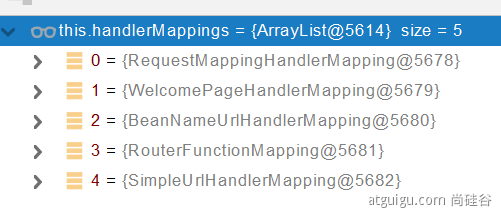
RequestMappingHandlerMapping:保存了所有@RequestMapping 和handler的映射规则。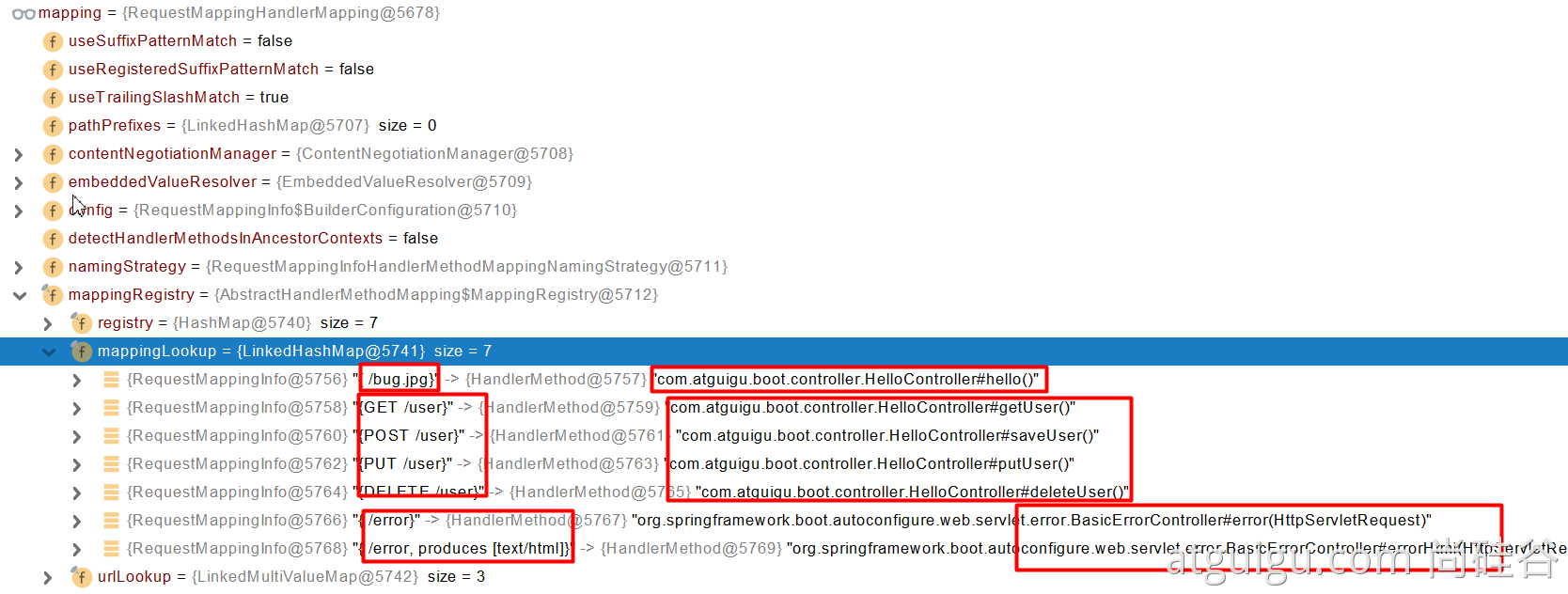
所有的请求映射都在HandlerMapping中。
- SpringBoot自动配置欢迎页的 WelcomePageHandlerMapping 。访问 /能访问到index.html;
- SpringBoot自动配置了默认 的 RequestMappingHandlerMapping
- 请求进来,挨个尝试所有的HandlerMapping看是否有请求信息。
- 如果有就找到这个请求对应的handler
- 如果没有就是下一个 HandlerMapping
我们需要一些自定义的映射处理,我们也可以自己给容器中放HandlerMapping。自定义 HandlerMapping
protected HandlerExecutionChain getHandler(HttpServletRequest request) throws Exception { if (this.handlerMappings != null) { for (HandlerMapping mapping : this.handlerMappings) { HandlerExecutionChain handler = mapping.getHandler(request); if (handler != null) { return handler; } } } return null; }
1、普通参数与基本注解
1.1、注解:
@PathVariable、@RequestHeader、@ModelAttribute、@RequestParam、@MatrixVariable、@CookieValue、@RequestBody
@RestController public class ParameterTestController { // car/2/owner/zhangsan @GetMapping(“/car/{id}/owner/{username}”) public Map
1.2、Servlet API:
WebRequest、ServletRequest、MultipartRequest、 HttpSession、javax.servlet.http.PushBuilder、Principal、InputStream、Reader、HttpMethod、Locale、TimeZone、ZoneId
ServletRequestMethodArgumentResolver 以上的部分参数
@Override public boolean supportsParameter(MethodParameter parameter) { Class<?> paramType = parameter.getParameterType(); return (WebRequest.class.isAssignableFrom(paramType) || ServletRequest.class.isAssignableFrom(paramType) || MultipartRequest.class.isAssignableFrom(paramType) || HttpSession.class.isAssignableFrom(paramType) || (pushBuilder != null && pushBuilder.isAssignableFrom(paramType)) || Principal.class.isAssignableFrom(paramType) || InputStream.class.isAssignableFrom(paramType) || Reader.class.isAssignableFrom(paramType) || HttpMethod.class == paramType || Locale.class == paramType || TimeZone.class == paramType || ZoneId.class == paramType); }
1.3、复杂参数:
Map、Model(map、model里面的数据会被放在request的请求域 request.setAttribute)、Errors/BindingResult、RedirectAttributes( 重定向携带数据)、ServletResponse(response)、SessionStatus、UriComponentsBuilder、ServletUriComponentsBuilder
Map
Map、Model类型的参数,会返回 mavContainer.getModel();—-> BindingAwareModelMap 是Model 也是Map
mavContainer.getModel(); 获取到值的
1.4、自定义对象参数:
可以自动类型转换与格式化,可以级联封装。
/* 姓名:
年龄:
生日:
宠物姓名:
宠物年龄: */ @Data public class Person { private String userName; private Integer age; private Date birth; private Pet pet; } @Data public class Pet { private String name; private String age; } result
2、POJO封装过程
- ServletModelAttributeMethodProcessor
3、参数处理原理
- HandlerMapping中找到能处理请求的Handler(Controller.method())
- 为当前Handler 找一个适配器 HandlerAdapter; RequestMappingHandlerAdapter
- 适配器执行目标方法并确定方法参数的每一个值
1、HandlerAdapter
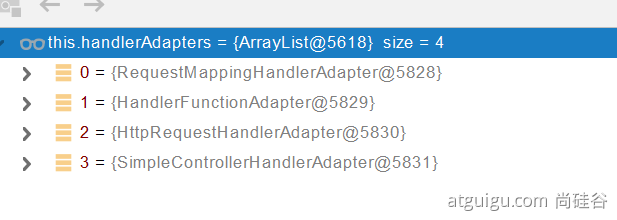
0 - 支持方法上标注@RequestMapping
1 - 支持函数式编程的
xxxxxx
2、执行目标方法
// Actually invoke the handler. //DispatcherServlet — doDispatch mv = ha.handle(processedRequest, response, mappedHandler.getHandler());
mav = invokeHandlerMethod(request, response, handlerMethod); //执行目标方法 //ServletInvocableHandlerMethod Object returnValue = invokeForRequest(webRequest, mavContainer, providedArgs); //获取方法的参数值 Object[] args = getMethodArgumentValues(request, mavContainer, providedArgs);
3、参数解析器-HandlerMethodArgumentResolver
确定将要执行的目标方法的每一个参数的值是什么;
SpringMVC目标方法能写多少种参数类型。取决于参数解析器。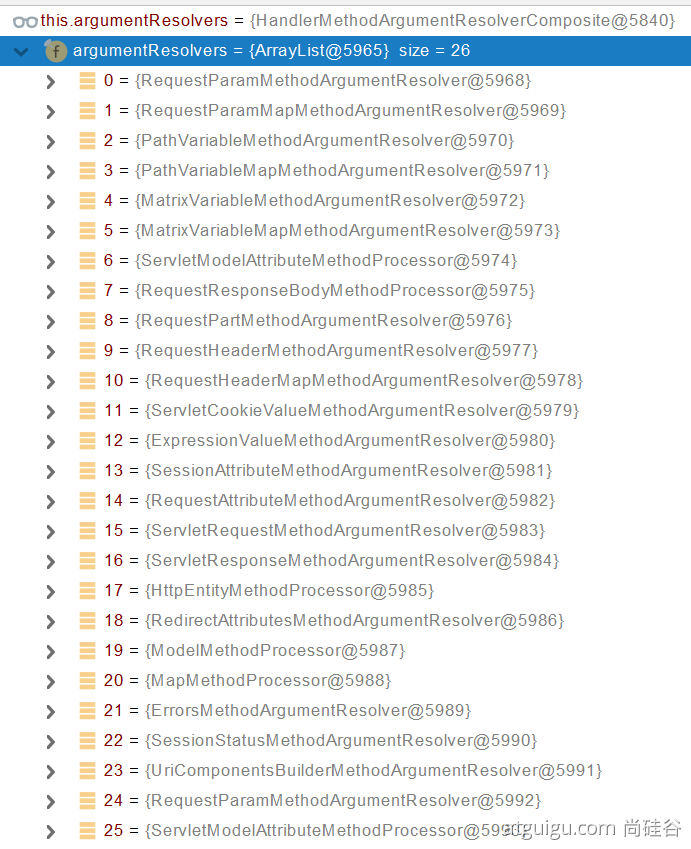

- 当前解析器是否支持解析这种参数
- 支持就调用 resolveArgument
4、返回值处理器
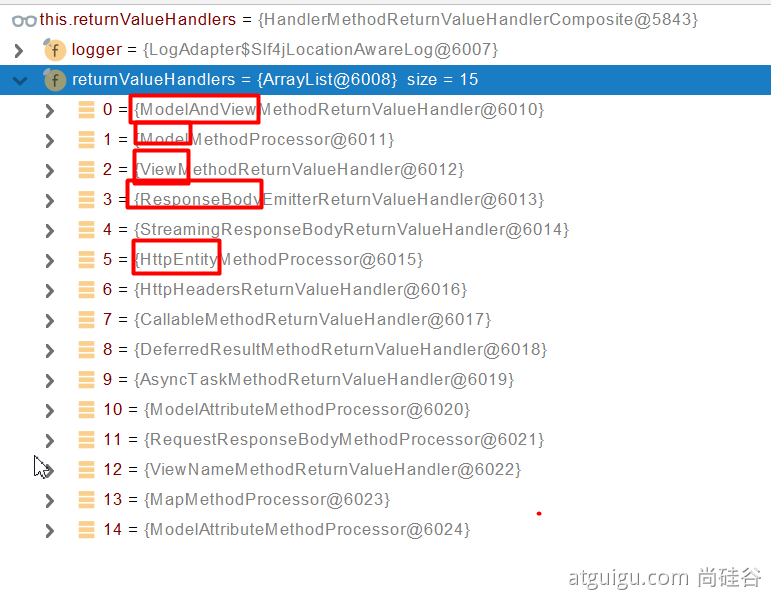
5、如何确定目标方法每一个参数的值
============InvocableHandlerMethod========================== protected Object[] getMethodArgumentValues(NativeWebRequest request, @Nullable ModelAndViewContainer mavContainer, Object… providedArgs) throws Exception { MethodParameter[] parameters = getMethodParameters(); if (ObjectUtils.isEmpty(parameters)) { return EMPTY_ARGS; } Object[] args = new Object[parameters.length]; for (int i = 0; i < parameters.length; i++) { MethodParameter parameter = parameters[i]; parameter.initParameterNameDiscovery(this.parameterNameDiscoverer); args[i] = findProvidedArgument(parameter, providedArgs); if (args[i] != null) { continue; } if (!this.resolvers.supportsParameter(parameter)) { throw new IllegalStateException(formatArgumentError(parameter, “No suitable resolver”)); } try { args[i] = this.resolvers.resolveArgument(parameter, mavContainer, request, this.dataBinderFactory); } catch (Exception ex) { // Leave stack trace for later, exception may actually be resolved and handled… if (logger.isDebugEnabled()) { String exMsg = ex.getMessage(); if (exMsg != null && !exMsg.contains(parameter.getExecutable().toGenericString())) { logger.debug(formatArgumentError(parameter, exMsg)); } } throw ex; } } return args; }
5.1、挨个判断所有参数解析器那个支持解析这个参数
@Nullable private HandlerMethodArgumentResolver getArgumentResolver(MethodParameter parameter) { HandlerMethodArgumentResolver result = this.argumentResolverCache.get(parameter); if (result == null) { for (HandlerMethodArgumentResolver resolver : this.argumentResolvers) { if (resolver.supportsParameter(parameter)) { result = resolver; this.argumentResolverCache.put(parameter, result); break; } } } return result; }
5.2、解析这个参数的值
调用各自 HandlerMethodArgumentResolver 的 resolveArgument 方法即可
5.3、自定义类型参数 封装POJO
ServletModelAttributeMethodProcessor 这个参数处理器支持
是否为简单类型。
public static boolean isSimpleValueType(Class<?> type) { return (Void.class != type && void.class != type && (ClassUtils.isPrimitiveOrWrapper(type) || Enum.class.isAssignableFrom(type) || CharSequence.class.isAssignableFrom(type) || Number.class.isAssignableFrom(type) || Date.class.isAssignableFrom(type) || Temporal.class.isAssignableFrom(type) || URI.class == type || URL.class == type || Locale.class == type || Class.class == type)); }
@Override @Nullable public final Object resolveArgument(MethodParameter parameter, @Nullable ModelAndViewContainer mavContainer, NativeWebRequest webRequest, @Nullable WebDataBinderFactory binderFactory) throws Exception { Assert.state(mavContainer != null, “ModelAttributeMethodProcessor requires ModelAndViewContainer”); Assert.state(binderFactory != null, “ModelAttributeMethodProcessor requires WebDataBinderFactory”); String name = ModelFactory.getNameForParameter(parameter); ModelAttribute ann = parameter.getParameterAnnotation(ModelAttribute.class); if (ann != null) { mavContainer.setBinding(name, ann.binding()); } Object attribute = null; BindingResult bindingResult = null; if (mavContainer.containsAttribute(name)) { attribute = mavContainer.getModel().get(name); } else { // Create attribute instance try { attribute = createAttribute(name, parameter, binderFactory, webRequest); } catch (BindException ex) { if (isBindExceptionRequired(parameter)) { // No BindingResult parameter -> fail with BindException throw ex; } // Otherwise, expose null/empty value and associated BindingResult if (parameter.getParameterType() == Optional.class) { attribute = Optional.empty(); } bindingResult = ex.getBindingResult(); } } if (bindingResult == null) { // Bean property binding and validation; // skipped in case of binding failure on construction. WebDataBinder binder = binderFactory.createBinder(webRequest, attribute, name); if (binder.getTarget() != null) { if (!mavContainer.isBindingDisabled(name)) { bindRequestParameters(binder, webRequest); } validateIfApplicable(binder, parameter); if (binder.getBindingResult().hasErrors() && isBindExceptionRequired(binder, parameter)) { throw new BindException(binder.getBindingResult()); } } // Value type adaptation, also covering java.util.Optional if (!parameter.getParameterType().isInstance(attribute)) { attribute = binder.convertIfNecessary(binder.getTarget(), parameter.getParameterType(), parameter); } bindingResult = binder.getBindingResult(); } // Add resolved attribute and BindingResult at the end of the model Map
WebDataBinder binder = binderFactory.createBinder(webRequest, attribute, name);
WebDataBinder :web数据绑定器,将请求参数的值绑定到指定的JavaBean里面
WebDataBinder 利用它里面的 Converters 将请求数据转成指定的数据类型。再次封装到JavaBean中
GenericConversionService:在设置每一个值的时候,找它里面的所有converter那个可以将这个数据类型(request带来参数的字符串)转换到指定的类型(JavaBean — Integer)
byte — > file
@FunctionalInterfacepublic interface Converter
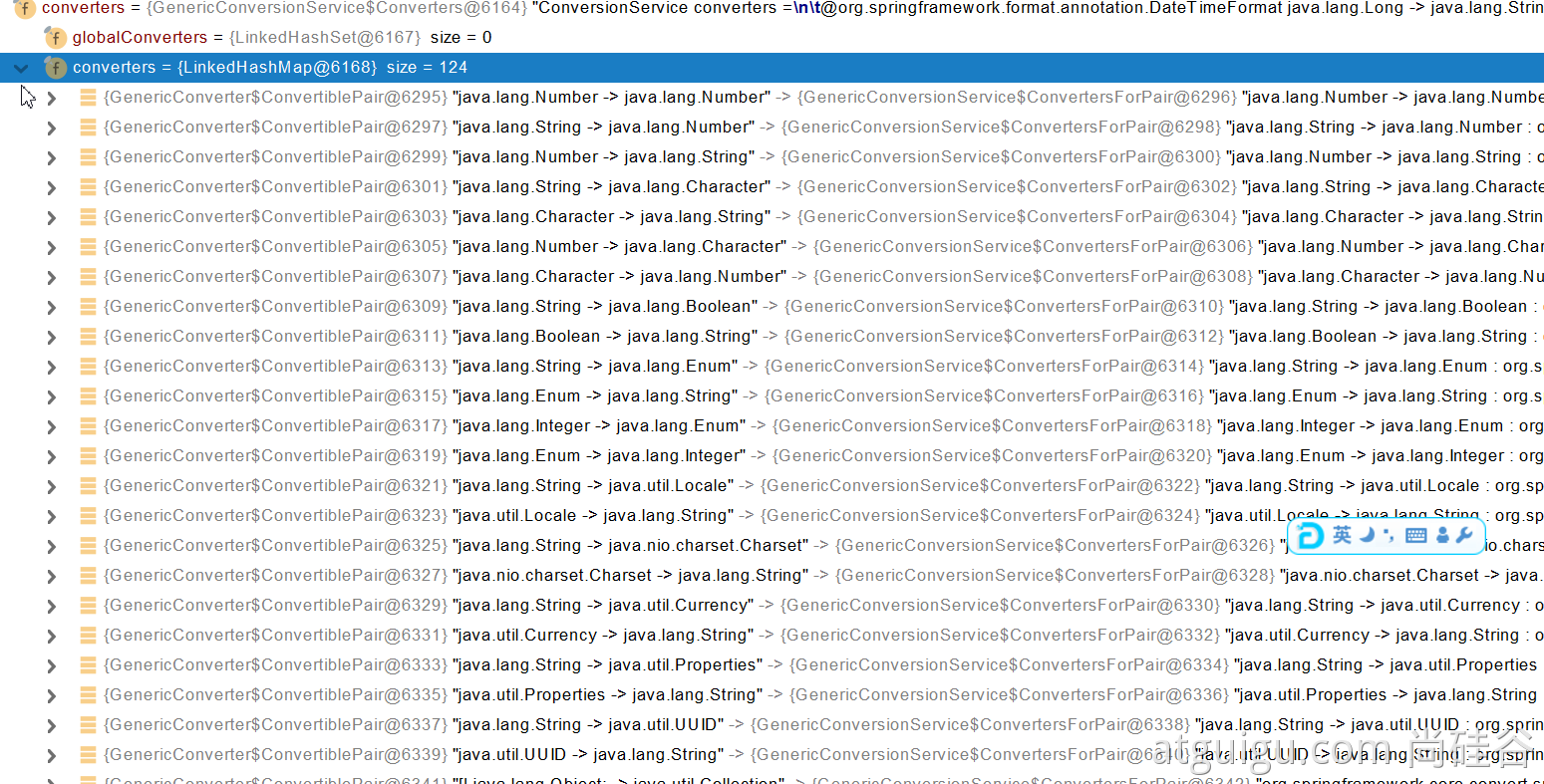
未来我们可以给WebDataBinder里面放自己的Converter;
private static final class StringToNumber
自定义 Converter
//1、WebMvcConfigurer定制化SpringMVC的功能 @Bean public WebMvcConfigurer webMvcConfigurer(){ return new WebMvcConfigurer() { @Override public void configurePathMatch(PathMatchConfigurer configurer) { UrlPathHelper urlPathHelper = new UrlPathHelper(); // 不移除;后面的内容。矩阵变量功能就可以生效 urlPathHelper.setRemoveSemicolonContent(false); configurer.setUrlPathHelper(urlPathHelper); } @Override public void addFormatters(FormatterRegistry registry) { registry.addConverter(new Converter
6、目标方法执行完成
将所有的数据都放在 ModelAndViewContainer;包含要去的页面地址View。还包含Model数据。
7、处理派发结果
processDispatchResult(processedRequest, response, mappedHandler, mv, dispatchException);
renderMergedOutputModel(mergedModel, getRequestToExpose(request), response);
InternalResourceView: @Override protected void renderMergedOutputModel( Map
暴露模型作为请求域属性 // Expose the model object as request attributes. exposeModelAsRequestAttributes(model, request);
protected void exposeModelAsRequestAttributes(Map
4、数据响应与内容协商
1、响应JSON
1.1、jackson.jar+@ResponseBody
<dependency> <groupId>org.springframework.boot</groupId> <artifactId>spring-boot-starter-web</artifactId> </dependency> web场景自动引入了json场景 <dependency> <groupId>org.springframework.boot</groupId> <artifactId>spring-boot-starter-json</artifactId> <version>2.3.4.RELEASE</version> <scope>compile</scope> </dependency>
给前端自动返回json数据;
1、返回值解析器
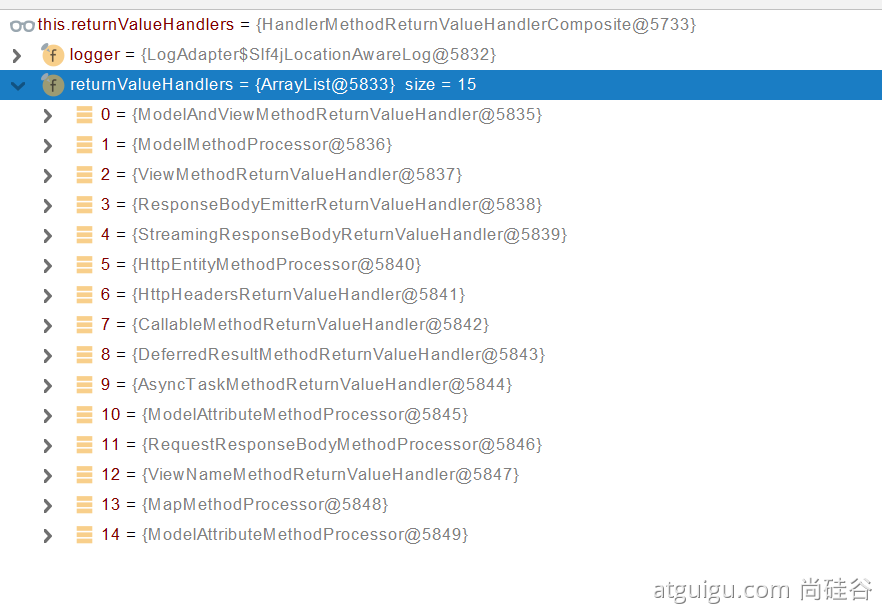
try { this.returnValueHandlers.handleReturnValue( returnValue, getReturnValueType(returnValue), mavContainer, webRequest); }
@Override public void handleReturnValue(@Nullable Object returnValue, MethodParameter returnType, ModelAndViewContainer mavContainer, NativeWebRequest webRequest) throws Exception { HandlerMethodReturnValueHandler handler = selectHandler(returnValue, returnType); if (handler == null) { throw new IllegalArgumentException(“Unknown return value type: “ + returnType.getParameterType().getName()); } handler.handleReturnValue(returnValue, returnType, mavContainer, webRequest); }
RequestResponseBodyMethodProcessor @Override public void handleReturnValue(@Nullable Object returnValue, MethodParameter returnType, ModelAndViewContainer mavContainer, NativeWebRequest webRequest) throws IOException, HttpMediaTypeNotAcceptableException, HttpMessageNotWritableException { mavContainer.setRequestHandled(true); ServletServerHttpRequest inputMessage = createInputMessage(webRequest); ServletServerHttpResponse outputMessage = createOutputMessage(webRequest); // Try even with null return value. ResponseBodyAdvice could get involved. // 使用消息转换器进行写出操作 writeWithMessageConverters(returnValue, returnType, inputMessage, outputMessage); }
2、返回值解析器原理
- 1、返回值处理器判断是否支持这种类型返回值 supportsReturnType
- 2、返回值处理器调用 handleReturnValue 进行处理
- 3、RequestResponseBodyMethodProcessor 可以处理返回值标了@ResponseBody 注解的。
- 利用 MessageConverters 进行处理 将数据写为json
- 1、内容协商(浏览器默认会以请求头的方式告诉服务器他能接受什么样的内容类型)
- 2、服务器最终根据自己自身的能力,决定服务器能生产出什么样内容类型的数据,
- 3、SpringMVC会挨个遍历所有容器底层的 HttpMessageConverter ,看谁能处理?
- 1、得到MappingJackson2HttpMessageConverter可以将对象写为json
- 2、利用MappingJackson2HttpMessageConverter将对象转为json再写出去。
- 利用 MessageConverters 进行处理 将数据写为json

1.2、SpringMVC到底支持哪些返回值
ModelAndView Model View ResponseEntity ResponseBodyEmitter StreamingResponseBody HttpEntity HttpHeaders Callable DeferredResult ListenableFuture CompletionStage WebAsyncTask 有 @ModelAttribute 且为对象类型的 @ResponseBody 注解 —-> RequestResponseBodyMethodProcessor;
1.3、HTTPMessageConverter原理
1、MessageConverter规范
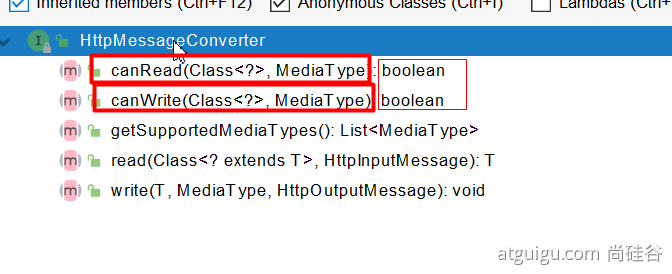
HttpMessageConverter: 看是否支持将 此 Class类型的对象,转为MediaType类型的数据。
例子:Person对象转为JSON。或者 JSON转为Person
2、默认的MessageConverter
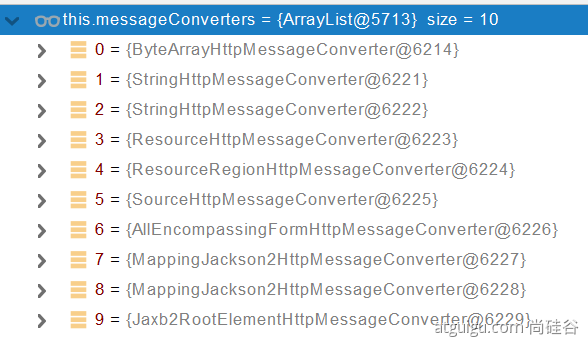
0 - 只支持Byte类型的
1 - String
2 - String
3 - Resource
4 - ResourceRegion
5 - DOMSource.class \ SAXSource.class) \ StAXSource.class \StreamSource.class \Source.class
6 - MultiValueMap
7 - true
8 - true
9 - 支持注解方式xml处理的。
最终 MappingJackson2HttpMessageConverter 把对象转为JSON(利用底层的jackson的objectMapper转换的)
2、内容协商
1、引入xml依赖
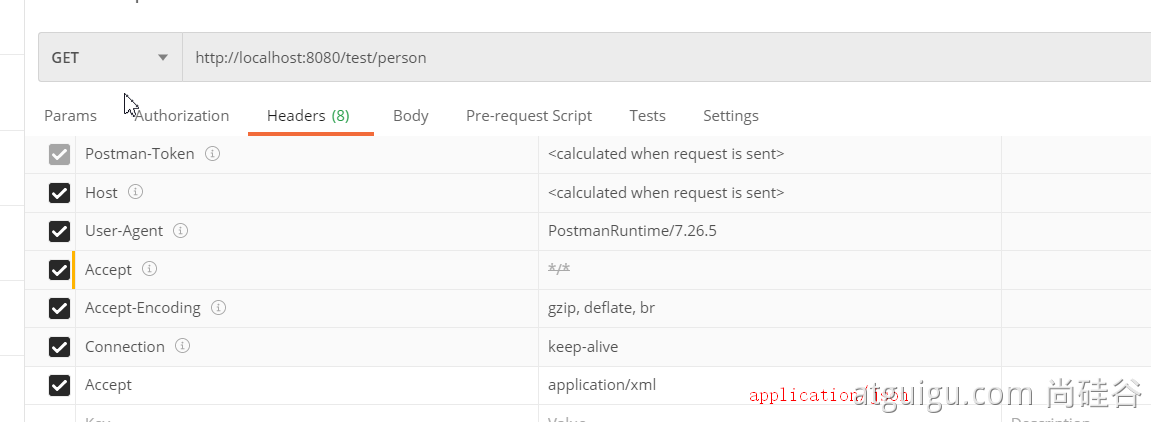 ### 3、开启浏览器参数方式内容协商功能
为了方便内容协商,开启基于请求参数的内容协商功能。
### 3、开启浏览器参数方式内容协商功能
为了方便内容协商,开启基于请求参数的内容协商功能。spring: contentnegotiation: favor-parameter: true #开启请求参数内容协商模式
发请求: http://localhost:8080/test/person?format=json
http://localhost:8080/test/person?format=xml
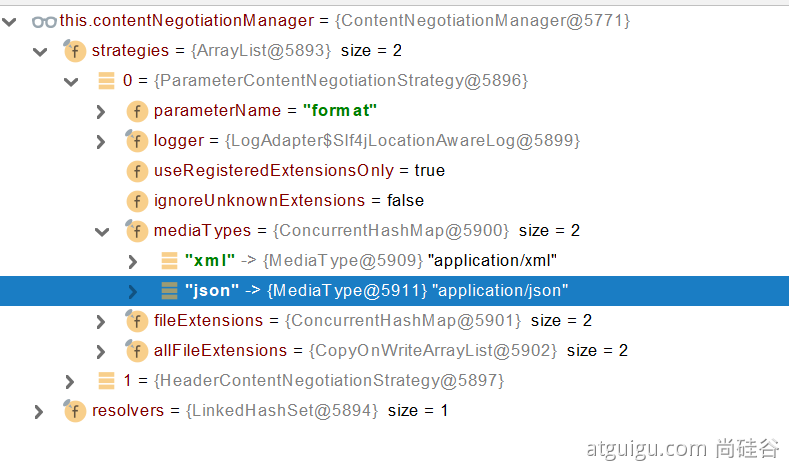
确定客户端接收什么样的内容类型;
1、Parameter策略优先确定是要返回json数据(获取请求头中的format的值)

2、最终进行内容协商返回给客户端json即可。 ### 4、内容协商原理 - 1、判断当前响应头中是否已经有确定的媒体类型。MediaType - 2、获取客户端(PostMan、浏览器)支持接收的内容类型。(获取客户端Accept请求头字段)【application/xml】 - contentNegotiationManager 内容协商管理器 默认使用基于请求头的策略 -
 - HeaderContentNegotiationStrategy 确定客户端可以接收的内容类型
-
- HeaderContentNegotiationStrategy 确定客户端可以接收的内容类型
-  - 3、遍历循环所有当前系统的 MessageConverter,看谁支持操作这个对象(Person)
- 4、找到支持操作Person的converter,把converter支持的媒体类型统计出来。
- 5、客户端需要【application/xml】。服务端能力【10种、json、xml】
-
- 3、遍历循环所有当前系统的 MessageConverter,看谁支持操作这个对象(Person)
- 4、找到支持操作Person的converter,把converter支持的媒体类型统计出来。
- 5、客户端需要【application/xml】。服务端能力【10种、json、xml】
- 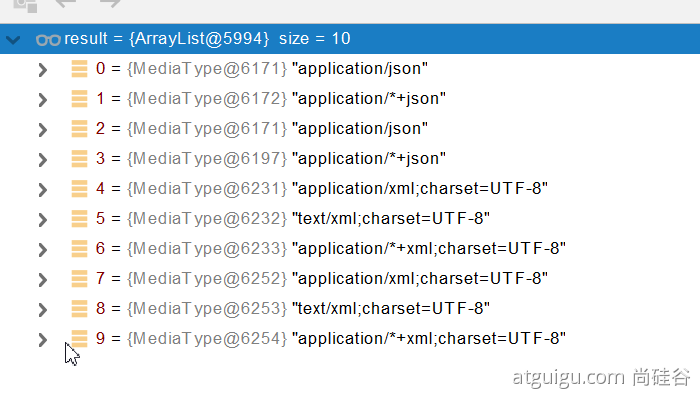 - 6、进行内容协商的最佳匹配媒体类型
- 7、用 支持 将对象转为 最佳匹配媒体类型 的converter。调用它进行转化 。
- 6、进行内容协商的最佳匹配媒体类型
- 7、用 支持 将对象转为 最佳匹配媒体类型 的converter。调用它进行转化 。
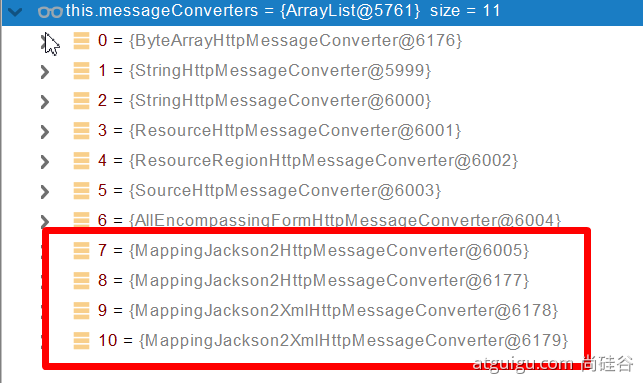
导入了jackson处理xml的包,xml的converter就会自动进来
WebMvcConfigurationSupport jackson2XmlPresent = ClassUtils.isPresent(“com.fasterxml.jackson.dataformat.xml.XmlMapper”, classLoader); if (jackson2XmlPresent) { Jackson2ObjectMapperBuilder builder = Jackson2ObjectMapperBuilder.xml(); if (this.applicationContext != null) { builder.applicationContext(this.applicationContext); } messageConverters.add(new MappingJackson2XmlHttpMessageConverter(builder.build())); } ### 5、自定义 MessageConverter 实现多协议数据兼容。json、xml、x-guigu
0、@ResponseBody 响应数据出去 调用 RequestResponseBodyMethodProcessor 处理
1、Processor 处理方法返回值。通过 MessageConverter 处理
2、所有 MessageConverter 合起来可以支持各种媒体类型数据的操作(读、写)
3、内容协商找到最终的 messageConverter; SpringMVC的什么功能。一个入口给容器中添加一个 WebMvcConfigurer
@Bean public WebMvcConfigurer webMvcConfigurer(){ return new WebMvcConfigurer() { @Override public void extendMessageConverters(List
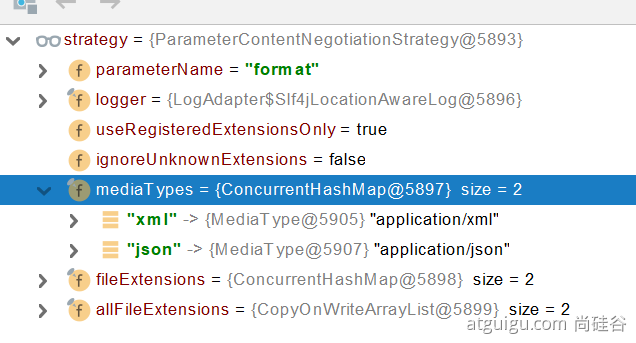
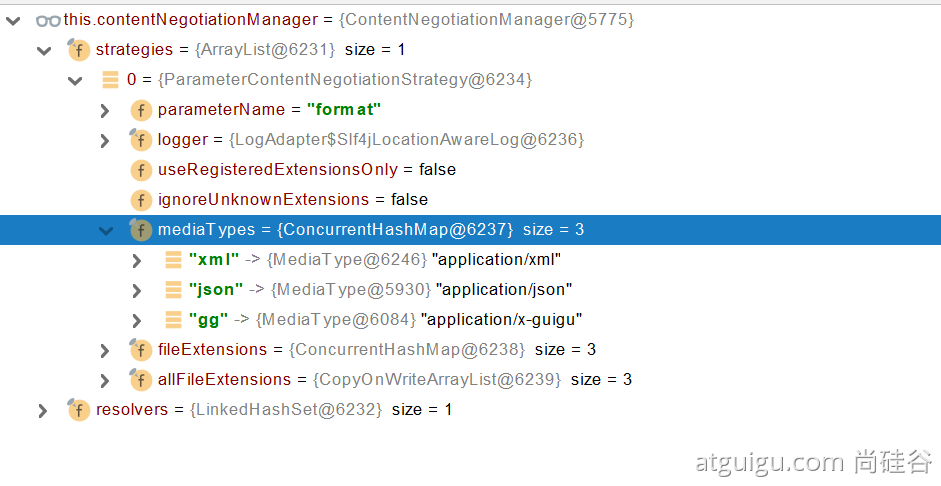 有可能我们添加的自定义的功能会覆盖默认很多功能,导致一些默认的功能失效。
有可能我们添加的自定义的功能会覆盖默认很多功能,导致一些默认的功能失效。大家考虑,上述功能除了我们完全自定义外?SpringBoot有没有为我们提供基于配置文件的快速修改媒体类型功能?怎么配置呢?【提示:参照SpringBoot官方文档web开发内容协商章节】 # 5、视图解析与模板引擎 视图解析:SpringBoot默认不支持 JSP,需要引入第三方模板引擎技术实现页面渲染。 ## 1、视图解析 ### 1、视图解析原理流程 1、目标方法处理的过程中,所有数据都会被放在 ModelAndViewContainer 里面。包括数据和视图地址
2、方法的参数是一个自定义类型对象(从请求参数中确定的),把他重新放在 ModelAndViewContainer
3、任何目标方法执行完成以后都会返回 ModelAndView(数据和视图地址)。
4、processDispatchResult 处理派发结果(页面改如何响应) - 1、render(mv, request, response); 进行页面渲染逻辑 - 1、根据方法的String返回值得到 View 对象【定义了页面的渲染逻辑】 - 1、所有的视图解析器尝试是否能根据当前返回值得到View对象 - 2、得到了 redirect:/main.html —> Thymeleaf new RedirectView() - 3、ContentNegotiationViewResolver 里面包含了下面所有的视图解析器,内部还是利用下面所有视图解析器得到视图对象。 - 4、view.render(mv.getModelInternal(), request, response); 视图对象调用自定义的render进行页面渲染工作 - RedirectView 如何渲染【重定向到一个页面】 - 1、获取目标url地址 - 2、response.sendRedirect(encodedURL); 视图解析: - 返回值以 forward: 开始: new InternalResourceView(forwardUrl); —> 转发request.getRequestDispatcher(path).forward(request, response); - 返回值以 redirect: 开始: new RedirectView() —》 render就是重定向 - 返回值是普通字符串: new ThymeleafView()—-> 自定义视图解析器+自定义视图; 大厂学院。


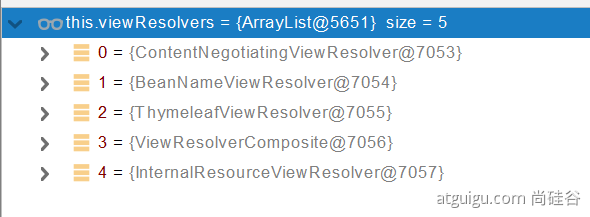
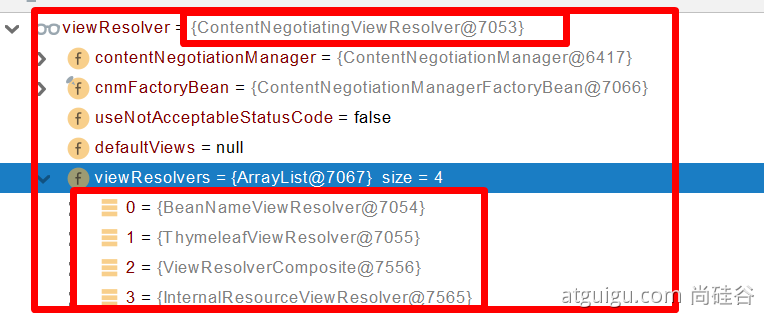 ## 2、模板引擎-Thymeleaf
### 1、thymeleaf简介
Thymeleaf is a modern server-side Java template engine for both web and standalone environments, capable of processing HTML, XML, JavaScript, CSS and even plain text.
## 2、模板引擎-Thymeleaf
### 1、thymeleaf简介
Thymeleaf is a modern server-side Java template engine for both web and standalone environments, capable of processing HTML, XML, JavaScript, CSS and even plain text.现代化、服务端Java模板引擎 ### 2、基本语法 #### 1、表达式 | 表达式名字 | 语法 | 用途 | | —- | —- | —- | | 变量取值 | ${…} | 获取请求域、session域、对象等值 | | 选择变量 | {…} | 获取上下文对象值 | | 消息 | #{…} | 获取国际化等值 | | 链接 | @{…} | 生成链接 | | 片段表达式 | ~{…} | jsp:include 作用,引入公共页面片段 | #### 2、字面量 文本值: ‘one text’ , ‘Another one!’ ,…数字: 0 , 34 , 3.0 , 12.3 ,…布尔值: true , false
空值: null
变量: one,two,…. 变量不能有空格 #### 3、文本操作 字符串拼接: +
变量替换: |The name is ${name}| #### 4、数学运算 运算符: + , - , , / , % #### 5、布尔运算 运算符: and , or
一元运算: ! , not #### 6、比较运算 比较: > , < , >= , <= ( gt , lt , ge , le )等式: == , != ( eq , ne ) #### 7、条件运算 If-then: (if) ? (then)
If-then-else: (if) ? (then) : (else)
Default: (value) ?: (defaultvalue) #### 8、特殊操作 无操作: _ ### 3、设置属性值-th:attr 设置单个值
设置多个值
 以上两个的代替写法 th:xxxx
以上两个的代替写法 th:xxxx

